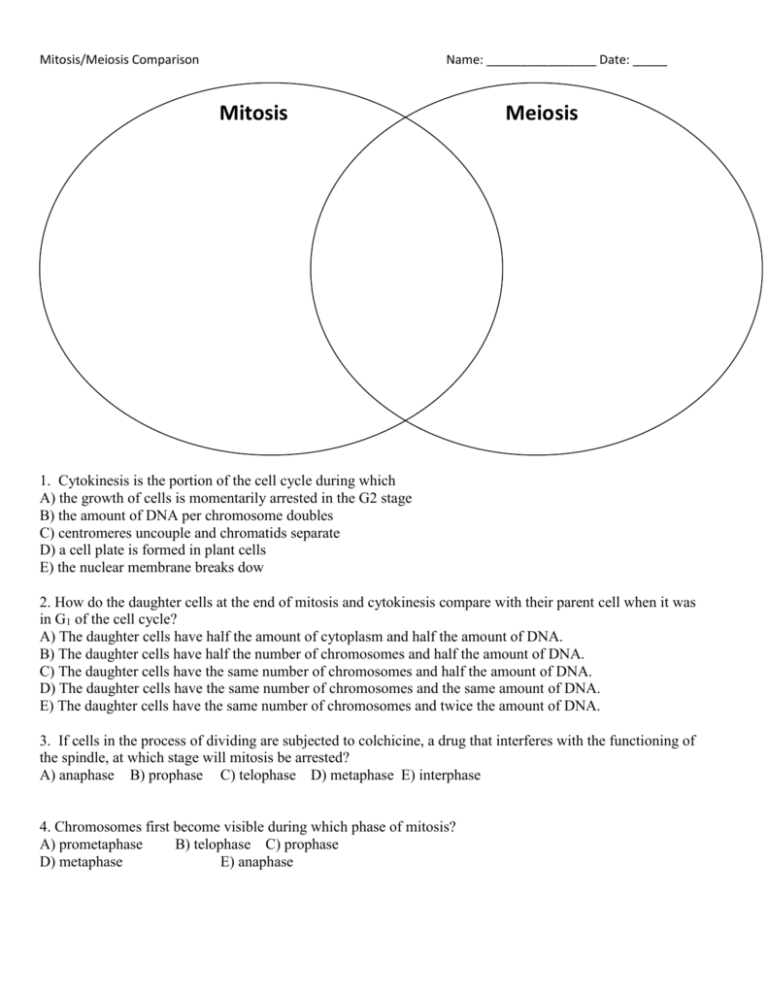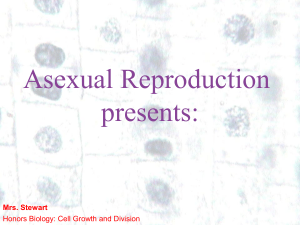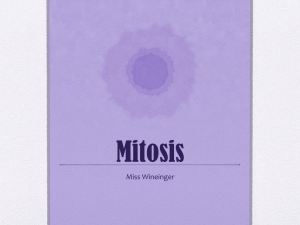Mitosis Meiosis
advertisement

Mitosis/Meiosis Comparison Name: ________________ Date: _____ Mitosis Meiosis 1. Cytokinesis is the portion of the cell cycle during which A) the growth of cells is momentarily arrested in the G2 stage B) the amount of DNA per chromosome doubles C) centromeres uncouple and chromatids separate D) a cell plate is formed in plant cells E) the nuclear membrane breaks dow 2. How do the daughter cells at the end of mitosis and cytokinesis compare with their parent cell when it was in G1 of the cell cycle? A) The daughter cells have half the amount of cytoplasm and half the amount of DNA. B) The daughter cells have half the number of chromosomes and half the amount of DNA. C) The daughter cells have the same number of chromosomes and half the amount of DNA. D) The daughter cells have the same number of chromosomes and the same amount of DNA. E) The daughter cells have the same number of chromosomes and twice the amount of DNA. 3. If cells in the process of dividing are subjected to colchicine, a drug that interferes with the functioning of the spindle, at which stage will mitosis be arrested? A) anaphase B) prophase C) telophase D) metaphase E) interphase 4. Chromosomes first become visible during which phase of mitosis? A) prometaphase B) telophase C) prophase D) metaphase E) anaphase 5. Most cells that have become transformed into cancer cells have which of the following characteristics when compared to normal, healthy cells? A) shorter cell cycle B) more carefully regulated rates of cell division C) lower rates of mitosis D) higher rates of protein translation E) identical DNA 6. Which of the following is a protein maintained at constant levels throughout the cell cycle that requires cyclin to become catalytically active? A) PDGF B) MPF C) protein kinase D) cyclin E) Cdk 7. Which of the following triggers the cell's passage past the G2 checkpoint into mitosis? A) PDGF B) MPF C) protein kinase D) cyclin E) Cdk 8. Which of the following is true concerning cancer cells? A) They do not exhibit density-dependent inhibition when growing in culture. B) When they stop dividing, they do so at random points in the cell cycle. C) They are not subject to cell cycle controls. D) B and C only E) A, B, and C 9. Asexual reproduction results in identical offspring unless which of the following occurs? A) Natural selection B) Cloning C) Crossing over D) Mutation E) Environmental change 10. Which of the following is true of a species that has a chromosome number of 2n = 16? A) The species is diploid with 32 chromosomes per cell. B) The species has 16 sets of chromosomes per cell. C) Each cell has 8 homologous pairs. D) During the S phase of the cell cycle there will be 32 separate chromosomes. E) A gamete from this species has 4 chromosomes. 11. The karyotype of one species of primate has 48 chromosomes. In a particular female, cell division goes awry and she produces one of her eggs with an extra chromosome (25). The most probable source of this error would be a mistake in which of the following? A) Mitosis in her ovary B) Metaphase I of one meiotic event C) Telophase II of one meiotic event D) Telophase I of one meiotic event E) Either anaphase I or II 12. After telophase I of meiosis, the chromosomal makeup of each daughter cell is A) diploid, and the chromosomes are each composed of a single chromatid. B) diploid, and the chromosomes are each composed of two chromatids. C) haploid, and the chromosomes are each composed of a single chromatid. D) haploid, and the chromosomes are each composed of two chromatids. E) tetraploid, and the chromosomes are each composed of two chromatids









